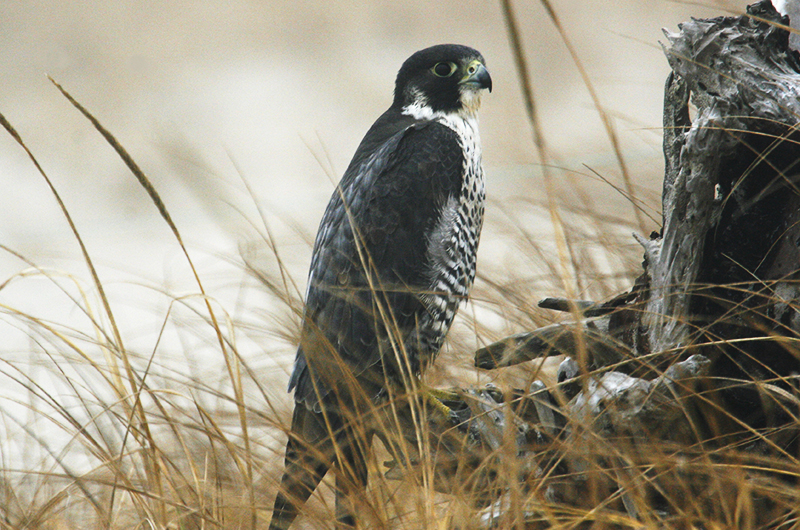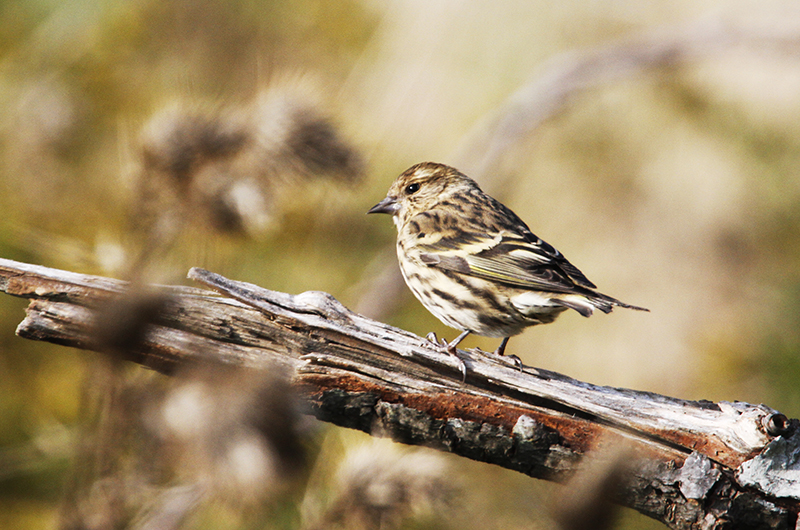Coniferous seeds in the boreal forests of Canada are in short supply this fall. And so the prediction is that many of the winter finches will head further south than they normally do. The first hint of this irruption is the abundance of red-breasted nuthatches over the past few weeks. They are reported from across the Island in numbers not seen in maybe five years.
The most recent evidence of this irruption is the arrival of purple finches. Allouise Waller Morgan had a flock of eight visiting her Edgartown feeders on Oct. 13, the same day that Gus BenDavid had two arrive at his Edgartown feeders. It is not just an Edgartown thing as Susan Whiting also reports a purple finch at Quenames that day and Luanne Johnson, Allan Keith and Lanny McDowell teamed up to find a rather remarkable 12 purple finches at the Gay Head cliffs on Oct. 14.
Susan Whiting observed another irruptive finch at her feeders on Oct. 13 and 14: two pine siskins. So that makes three irruptive species already seen this fall – red-breasted nuthatch, purple finch and pine siskin. Other irruptive species include crossbills, grosbeaks and redpolls, which may also be venturing this far south later this fall.
Two other seasonal residents are also arriving. Both species are eagerly anticipated and watched for by many people.
On Oct. 13 Sheila and Tim Baird were the first to spot the brant that frequent Ocean Park in Oak Bluffs. They are smaller than the Canada geese that also frequent the park and, most unusual for brant, this flock typically grazes on grass in the park. These are only the first of a flock that will number well into the hundreds within a month or two. Such grazing behavior is unusual for brant, which in most places tend to feed in shallow water eelgrass beds. Jason Flanders also reports seeing the three brant on Oct. 14, though he observed them nearby in Nantucket Sound near the bulkhead.
Fish crows are also returning for the season – they will be here through the winter. I heard their characteristic nasal “cah-cah” call and then I spotted two of them near the Oak Bluffs Police Station on Oct. 12. Their numbers will likely build to over a 1,000 individuals and they will frequent the downtown areas of Oak Bluffs and Vineyard Haven. We will also have a large number of them that commute from the Cape daily to roost near the Lambert’s Cove Inn every night.
Bird Sightings
Photographing a flock of birds can occasionally produce some surprises. Such was the case with Kath MayWaite’s Oct. 14 photographs of a flock of greater yellowlegs and one larger shorebird. Turns out the larger bird was a Hudsonian godwit that was feeding in the salt marshes near Bend in the Road Beach, and it was identified from the photographs. The only other sighting of this species this year was from Eel Pond a few weeks back.
Songbird migration has increased with the arrival of more seasonable cooler temperatures and some northwest winds. Luanne Johnson, Allan Keith and Lanny McDowell teamed up to bird the Gay Head cliffs area on Sept. 14. Their highlights include the 12 purple finches mentioned above as well as white-crowned sparrow, swamp sparrow, blackpoll, yellow-rumped, orange-crowned and Nashville warblers, scarlet tanager (they are not red at this time of the year), house wren, ruby-crowned kinglet, dickcissel, indigo bunting and three lesser yellowlegs flying by overhead.
Susan Whiting reports her feeders hosted the first dark-eyed juncos of the season on Oct 14. And Luanne Johnson found a golden-crowned kinglet at her house on Oct. 15.
Allan Keith adds eight wood ducks and four green-winged teal on his farm pond on Oct. 15. He also birded Norton Point and the beaches of Chappaquiddick on Oct. 14, where he found a peregrine falcon, 13 great blue herons and 17 great egrets. My Oct. 13 Guided Birding Tour found the following shorebirds lingering in the Katama area: nine American oystercatchers, semipalmated plover, killdeer, greater yellowlegs, black-bellied plover, sanderling and dunlin, as well as two common loons diving in Katama Bay.
David Stephens reports that a northern parula flew into a window at his house on Sept. 27. He held the tiny bird in his hand as it quickly recovered and flew off.
As the above reports show, the intensity of the migration has increased; cooler temperatures are expected to continue and there will be more westerly winds, so we can expect that migration will continue to be fairly heavy. This is about time, as it has been a fairly slow migration so far.
Also in the news, Martha Moore spotted an adult bald eagle at Long Point on Oct. 13, and she found a lingering osprey the previous day. And she has a flock of eastern bluebirds feeding on the bright red winterberry fruits.
Finally, while bobwhites have been making a comeback up-Island, they have remained absent from down-Island – until now. Lisa Maxfield heard and observed her first bobwhite at Brush Pond in decades. Are there any other quail this side of Panhandle Road? And Irene Ziebarth reports a ring-necked pheasant on Tennis Lane in Chilmark on Oct. 11 and 12.
Fall and winter resident species are now showing up. Please report all your sightings to birds@mvgazette.com.
Robert Culbert leads Saturday morning Guided Birding Tours and is an ecological consultant living in Vineyard Haven.








Comments
Comment policy »